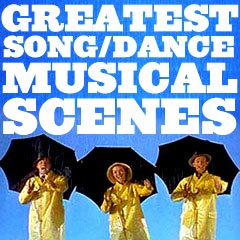
|
Musical Moments and Scenes F - 1 |
| F | ||
| Movie Title/Year and Scene Descriptions | ||

|
The Fabulous Baker Boys (1989) This film included the infamously torrid scene in which high-heeled, sensuous and slinky ex-hooker Susie Diamond (Michelle Pfeiffer), wearing a high-slit red dress, sang Makin' Whoopee (pictured). She slithered atop a slippery piano top, as piano lounge singer Jack Baker (Jeff Bridges) accompanied her and the camera executed a 360-degree circling around her. |
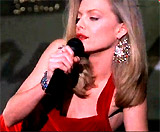
|
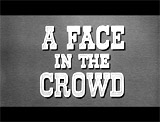
|
In this Elia Kazan-directed satirical political drama, Andy Griffith (in his first dramatic role) starred as Larry 'Lonesome' Rhodes - an opportunistic, smiling, drunken cornpone-spouting, back country Arkansas homeless drifter. Radio producer/interviewer Marcia Jeffries (Patricia Neal) first heard him strum his bluesy guitar in a rural Arkansas jail-cell, when he sang the home-spun song Free Man in the Morning (pictured twice). Soon, he became an overnight media celebrity on the radio and a mean-spirited demagogue on a Memphis TV show. |
 
|
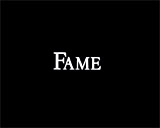
|
Fame (1980)
This 'feel-good' Alan Parker-directed dance musical (with an Oscar-winning Best Score by Michael Gore) showcased aspiring and gifted young performers. The film had six Oscar nominations (with two wins):
The popular film inspired a hit TV series and stage musical, and some of the young cast members became stars (Irene Cara, Debbie Allen, Richard Beltzer, and Meg Tilly). One of the most memorable scenes, accompanying the Oscar-winning title song, Fame (pictured) (sung by Coco (Irene Cara)): ("Baby, remember my name..."), involved New York City's High School of the Performing Arts wanna-be students who spilled out onto the street and danced atop NY taxi cabs and other cars. |
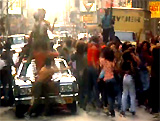
|
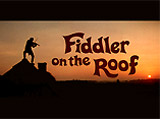
|
Fiddler on the Roof (1971) This Best Picture-nominated musical fable film (adapted from the Sholom Aleichem stories) by Best Director-nominated Norman Jewison successfully reproduced the long-running Broadway stage production on the screen with its romanticized Ukranian Russian ghetto village of Anatevka at the turn of the century. It garnered eight Academy Award nominations with three wins:
Its main character was charismatic, scheming, beleaguered, poor, Jewish-Russian, life-affirming peasant bearded milkman Teyve (Israeli actor Haim Topol - with a Best Actor nomination - replacing Zero Mostel from the stage). His songs included:
|
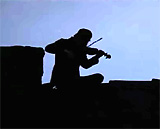   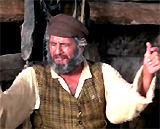 
|

|
The Fifth Element (1997, Fr.) In this writer-director science-fiction feature from Luc Besson, blue-skinned alien Diva Plavalaguna (Maïwenn Le Besco) sang the impossible, techno-styled Aria 'Lucia di Lammermoor' (pictured twice) (the notes were rumored to be electronically aided to go above and below human octave levels). It was choreographed to an accompanying fight scene as the beautiful, red-haired and ethereal alien Leeloo (Milla Jovovich) balletically dispatched invaders (Mangalores) in her chamber. |
 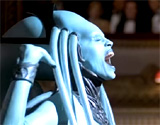
|
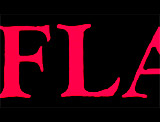 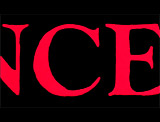
|
Flashdance (1983)
This R-rated sleeper hit from director Adrian Lyne received four Oscar nominations and won Best Song (Flashdance...What a Feeling! with music by Giorgio Moroder and lyrics by Keith Forsey). Its other nominations included another Best Song nominee: Michael Sembello's Maniac, also Best Film Editing, and Best Cinematography. The fast-moving movie included energetic, glossy music-video style dance sequences - especially in the Mawby's Bar sequence when Pittsburgh welder/exotic bar dancer Alexandra "Alex" Owens (Jennifer Beals) performed supine on a chair (mostly in dark silhouette) as water splashed down on her. She was accompanied by the song He's a Dream (pictured) sung by Shandi Sinnamon (as Shandi). Then she rose from the chair and danced in her wet red leotard. Also the film displayed:
|
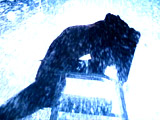    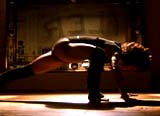 
|
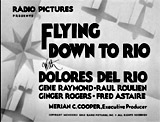
|
Flying Down to Rio (1933) This high-grossing RKO film marked the first pairing between Fred Astaire (as Fred Ayres) and Ginger Rogers (as Honey Hale) as supporting performers. Their star-making dance was in a brief debut dance number - during the lengthy sensual show-stopping The Carioca (pictured) (as the casino owner explained: "The American foxtrot is considered tame. Too dull...Our people prefer the Carioca"). The dance required the dancers to touch foreheads while clapsing hands - and then to execute a turn without losing forehead contact, as Fred commented: "I'd like to try this thing just once" and Ginger added: "We'll show 'em a thing or three." The film was most memorable, however, for the Flying Down to Rio number (pictured twice), with airplane wing-dancing/walking, skimpily-attired chorus girls atop biplane wings (filmed in an airplane hangar with wind machines and a few planes hanging from the ceiling - enhanced with backdrops of Rio and Malibu Beach), while Astaire danced below and sang the title song (pictured). |
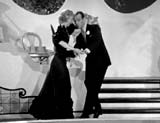 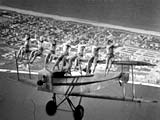 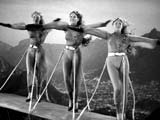 
|
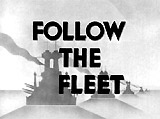
|
Follow the Fleet (1936) This nautical musical film marked the fifth teaming of Fred Astaire (as confident gum-chewing sailor "Bake" Baker) and Ginger Rogers (as cheap dance-hall hostess and Baker's former dance partner Sherry Martin) to the music of Irving Berlin. They played the parts of reunited dance performers after the fleet came to San Francisco, and were best known for their wistful, poignant, romantically-lyrical and elegant self-contained, staged mini-drama/song-and-dance aboard the ship, titled Let's Face the Music and Dance (pictured twice) - with many lifts and twirls featuring Rogers' billowing, art-deco beaded white dress with billowing sleeves on a moonlit terrace, with Astaire in his trademark tuxedo - with the two defiantly facing life's struggles (bankruptcy, suicide). They also performed the zany comic slapstick duet and dance I'm Putting All My Eggs In One Basket (pictured). Also memorable was their delightful show-within-a-show dance contest routine in the Paradise Ballroom titled Let Yourself Go (pictured) with Rogers wearing a satiny sailor suit - in the number (pictured), Rogers also sang the tune (her one solo singing performance in the entire set of Astaire/Rogers films) while backed by a trio of Jeanne Gray, Betty Grable, and Joy Hodges. |
 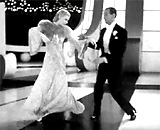 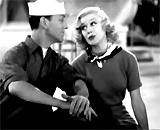  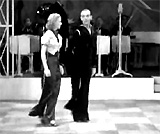
|
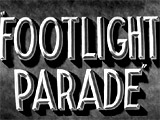
|
In this third backstage musical from Warner Bros in 1933 (after 42nd Street and Gold Diggers of 1933), from director Lloyd Bacon, the premise was that theatrical producer Chester Kent (James Cagney) was pressured to create three fantastic, spectacular and show-stopping musical numbers or "prologues" in only three days! In the film, the numbers were choreographed by Busby Berkeley. The "prologues" (short, live stage productions) were to be marketed to movie theatre owners as added pre-show musical attractions for their patrons - in fact, all of the "prologues" in the film were actually finales that were performed back-to-back in the musical's extravagant conclusion.
In between the second and third numbers, producer Kent fell down a staircase in a scuffle with the drunken lead actor and landed on-stage, where he was able to signal to the orchestra conductor to begin the musical prelude for the third and final number --
It closed with jingoistic configuration shots of an imperialistic, militaristic US Navy drill team of sailors, the Stars and Stripes American flag, the face of President Franklin D. Roosevelt (pictured), and the logo of the NRA's Blue Eagle. |
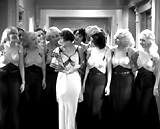 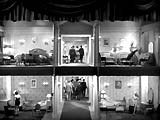 "Honeymoon Hotel" 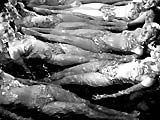  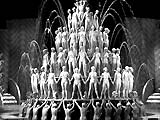 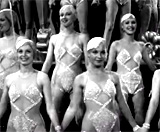 "By a Waterfall"    "Shanghai Lil" 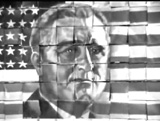
|

|
Footlight Serenade (1942) Fox's star Betty Grable appeared in this black and white musical (her last starring B/W film) as shapely chorine-dancer Pat Lambert starring in the Broadway show, Down and Out. She was pursued by arrogant champion heavyweight fighter Tommy Lundy (Victor Mature) in the lead role, her co-star (who was nicknamed "The Body Beautiful").. She also sang the duet I'm Still Crazy For You (pictured), during a balcony massage sequence, with her shirtless, secret husband William J. 'Bill' Smith (John Payne). At the end of the song, she asked him: "Darling, when does our wedding license expire?" He quipped: "Baby, when you drop a hint, you use a bomb..." and then added: "You're the most persistent, hard-headed, adorable person..." In one memorable number in which she wore boxing gloves, Grable sang and danced to I Heard the Birdies Sing (pictured) with the chorus. In the song, she described how falling in love was like being hit with a knock-out punch. During the sequence, she also shadow-boxed with herself (pictured). |
   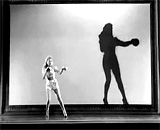
|
(alphabetical by film title) Introduction | A-1 | A-2 | B-1 | B-2 | B-3 | C-1 | C-2 | D-1 | D-2 | E | F-1 | F-2 | G-1 | G-2 H-1 | H-2 | I-J | K | L-1 | L-2 | M-1 | M-2 | N-O | P-1 | P-2 | R-1 | R-2 | S-1 | S-2 | S-3 | T | U-V | W | X-Z |